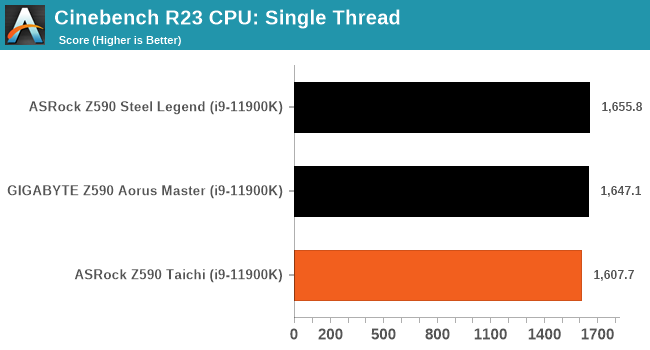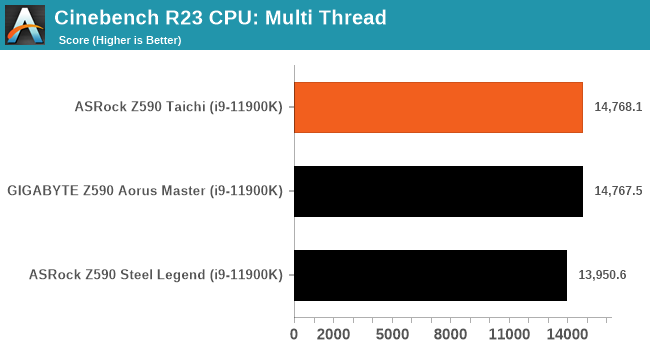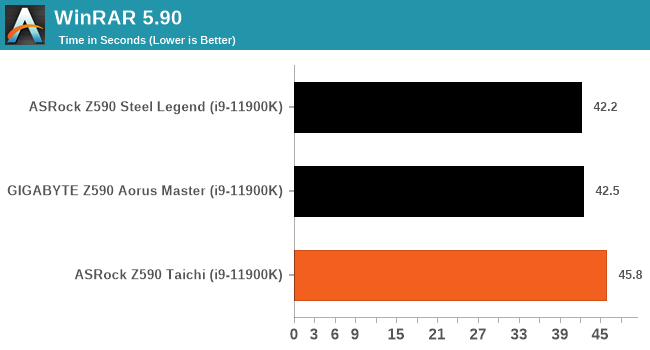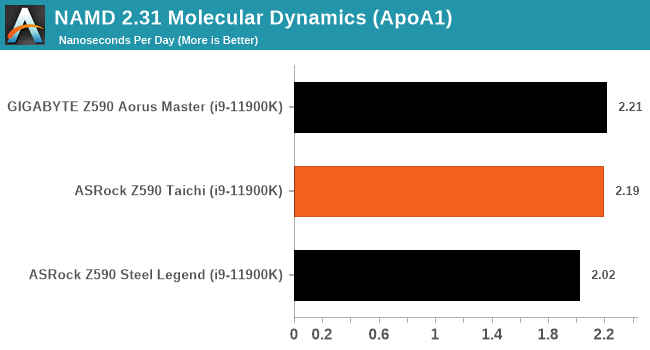ASRock Z590 Taichi Review: An Intel Motherboard with Moving Parts (and Thunderbolt 4)
by Gavin Bonshor on April 1, 2021 11:00 AM ESTCPU Performance, Short Form
For our motherboard reviews, we use our short form testing method. These tests usually focus on if a motherboard is using MultiCore Turbo (the feature used to have maximum turbo on at all times, giving a frequency advantage), or if there are slight gains to be had from tweaking the firmware. We put the memory settings at the CPU manufacturers suggested frequency, making it very easy to see which motherboards have MCT enabled by default.
For Z590 we are running using Windows 10 64-bit with the 20H2 update.
Rendering - Blender 2.7b: 3D Creation Suite
A high profile rendering tool, Blender is open-source allowing for massive amounts of configurability, and is used by a number of high-profile animation studios worldwide. The organization recently released a Blender benchmark package, a couple of weeks after we had narrowed our Blender test for our new suite, however their test can take over an hour. For our results, we run one of the sub-tests in that suite through the command line - a standard ‘bmw27’ scene in CPU only mode, and measure the time to complete the render.

Rendering – POV-Ray 3.7.1: Ray Tracing
The Persistence of Vision Ray Tracer, or POV-Ray, is a freeware package for as the name suggests, ray tracing. It is a pure renderer, rather than modeling software, but the latest beta version contains a handy benchmark for stressing all processing threads on a platform. We have been using this test in motherboard reviews to test memory stability at various CPU speeds to good effect – if it passes the test, the IMC in the CPU is stable for a given CPU speed. As a CPU test, it runs for approximately 1-2 minutes on high-end platforms.

Rendering - Crysis CPU Render
One of the most oft used memes in computer gaming is ‘Can It Run Crysis?’. The original 2007 game, built in the Crytek engine by Crytek, was heralded as a computationally complex title for the hardware at the time and several years after, suggesting that a user needed graphics hardware from the future in order to run it. Fast forward over a decade, and the game runs fairly easily on modern GPUs, but we can also apply the same concept to pure CPU rendering – can the CPU render Crysis? Since 64 core processors entered the market, one can dream. We built a benchmark to see whether the hardware can.
For this test, we’re running Crysis’ own GPU benchmark, but in CPU render mode. This is a 2000 frame test, which we run over a series of resolutions from 800x600 up to 1920x1080. For simplicity, we provide the 1080p test here.

Rendering - Cinebench R23: link
Maxon's real-world and cross-platform Cinebench test suite has been a staple in benchmarking and rendering performance for many years. Its latest installment is the R23 version, which is based on its latest 23 code which uses updated compilers. It acts as a real-world system benchmark that incorporates common tasks and rendering workloads as opposed to less diverse benchmarks which only take measurements based on certain CPU functions. Cinebench R23 can also measure both single-threaded and multi-threaded performance.


Compression – WinRAR 5.60b3: link
Our WinRAR test from 2013 is updated to the latest version of WinRAR at the start of 2014. We compress a set of 2867 files across 320 folders totaling 1.52 GB in size – 95% of these files are small typical website files, and the rest (90% of the size) are small 30-second 720p videos.

3DPMv2.1 – 3D Movement Algorithm Test: link
3DPM is a self-penned benchmark, taking basic 3D movement algorithms used in Brownian Motion simulations and testing them for speed. High floating point performance, MHz, and IPC win in the single thread version, whereas the multithread version has to handle the threads and loves more cores. For a brief explanation of the platform agnostic coding behind this benchmark, see my forum post here.

NAMD 2.13 (ApoA1): Molecular Dynamics
One frequent request over the years has been for some form of molecular dynamics simulation. Molecular dynamics forms the basis of a lot of computational biology and chemistry when modeling specific molecules, enabling researchers to find low energy configurations or potential active binding sites, especially when looking at larger proteins. We’re using the NAMD software here, or Nanoscale Molecular Dynamics, often cited for its parallel efficiency. Unfortunately the version we’re using is limited to 64 threads on Windows, but we can still use it to analyze our processors. We’re simulating the ApoA1 protein for 10 minutes, and reporting back the ‘nanoseconds per day’ that our processor can simulate. Molecular dynamics is so complex that yes, you can spend a day simply calculating a nanosecond of molecular movement.












50 Comments
View All Comments
DanNeely - Friday, April 2, 2021 - link
I can't decide if the basic idea itself is the most absurdly pitiful bit, or it's that they superimposed a non-moving gear on top of the one that does move.TheinsanegamerN - Monday, April 5, 2021 - link
$429 is a rediculous price.Taichi ultimates used to cost under $400, and came with two ethernet ports AND a 10G ethernet port. They came with plenty of PCIe lanes as well. This taichi at $429 is a ripoff.
Oxford Guy - Tuesday, April 6, 2021 - link
Inflation is very high right now. Products are going up 30%, 50%, 100%, etc.It was high even before COVID and the trillions in dollars that were printed in response.
edwpang - Monday, April 5, 2021 - link
Motherboard used to have a fan to cool down the northbridge chip. That's more useful than this one!ltkAlpha - Monday, April 5, 2021 - link
The moving cogwheel... The fact that whoever decided this was a good idea was in a position to make that decision makes me depresses me.Oxford Guy - Tuesday, April 6, 2021 - link
It's less offensive than Intel putting skulls on its SSDs. That has to be the #1 stupidest.Mikuni - Saturday, April 10, 2021 - link
April's fools80-wattHamster - Monday, April 12, 2021 - link
Purely aesthetic cogwheel isn't any more ridiculous than purely aesthetic RGB lighting, but I don't see anyone getting their knickers in a twist about that.kkromm - Saturday, April 17, 2021 - link
The 2.5G port is a complete gimmick. I have a 2009 Mac Pro with a 10g card a 2017 pc with a 10g fiber card a 2019 Mac Pro with 2 10g ports but a should get excited with 2021 motherboard that has a 2.5G port that would not even work as a 2.5G port with my 10g Netgear equipment (m430024x24f) because it does not recognize 2.5G and knocks it down to 1g. Do you even know how networks work? Do you know that I would have to get a $500 multi speed switch (ms510txm) just for a 2.5G port to work on my network but you are all excited by a 2.5G port...give me a break!kims123 - Sunday, April 18, 2021 - link
really it was to be unique...great thought what u have done like that...i would be look great..